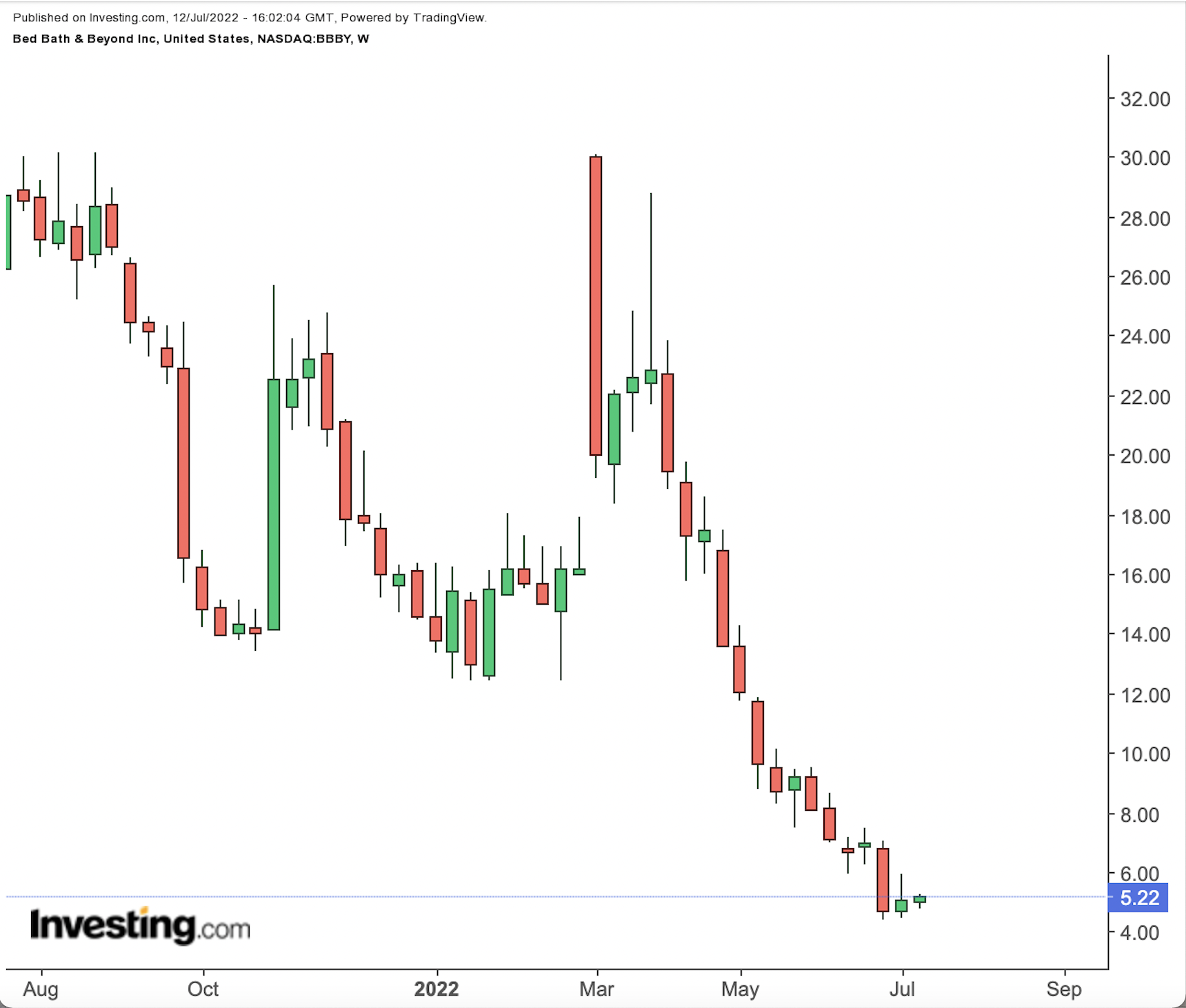- BBBY stock has collapsed 83% from early-year highs
- That decline doesn’t make the stock a buy; this remains an indebted, sharply unprofitable business
- Bed Bath & Beyond bond prices, rather than the stock price, highlight the company’s real risk
Even by the current standards of a plunging retail sector, the sell-off in Bed Bath & Beyond (NASDAQ:BBBY) has been breathtaking. As recently as late March, BBBY traded above $28, but after losing around 83%, the stock closed Monday below $5. Incredibly, shares are threatening levels seen during the worst of the March 2020 COVID crash.

Source: Investing.com
The size and speed of the decline might tempt some investors into believing the stock is too cheap. But as we’ve emphasized elsewhere, focusing on the size of a sell-off is a classic investing error known as anchoring bias.
This market has consistently punished that error. Many pandemic winners—among them the likes of Peloton Interactive (NASDAQ:PTON) and Coinbase (NASDAQ:COIN)—declined 70% or 80% and then continued to fall.
Yes, BBBY Was A Pandemic Winner
It’s become obvious that, contrary to initial expectations, U.S. retailers benefited from the novel coronavirus pandemic. Between stimulus payments from the federal government and limited spending on travel and entertainment, consumers had plenty of cash and not much to spend it on beyond sprucing up their homes.
The problem now is that there simply isn’t that much left to buy, as evidenced by the inventory challenges at even leading retailers like Target (NYSE:TGT) and Walmart (NYSE:WMT).
For Bed Bath & Beyond, the pandemic now looks like a brief reprieve from a long period of operating weakness. Same-store sales are the lifeblood of a retailer and the only way for retail profits to grow consistently. Bed Bath & Beyond had struggled for years before the pandemic: same-store sales growth on average was negative between fiscal 2015 and fiscal 2018 (fiscal years end the following February) before BBBY posted a 6.8% decline in FY19.
The declines have returned with a vengeance. Comparable sales fell 12% in the fiscal fourth quarter, leading to a massive profit miss relative to expectations. Q1 was even worse: comparable sales (which include online activity) plunged 23% year-over-year.
Wall Street analysts now expect total sales to decline 17% this year — and, on average, project Bed Bath & Beyond to post a loss of more than $6 per share. Three months ago, those same analysts expected Bed Bath & Beyond to turn a profit.
The Case Against Bed Bath & Beyond Stock
The combination here is untenable. Declining comparable sales, steep losses and an indebted balance sheet—Bed Bath & Beyond has over $1 billion in debt—is a brutal combination for a retailer. Bed Bath & Beyond needs to turn its business around.
Of course, the company has been trying to do so for years now. GameStop (NYSE:GME) chairman and significant BBBY shareholder Ryan Cohen made exactly that point in a letter to management in March. As shown by pre-pandemic sales figures—and a plunge in BBBY stock from almost $80 in early 2015 to $10 five years later—those efforts never worked.
There perhaps is some hope still. BBBY is bringing in a new chief executive officer. There has been speculation about a sale of the buybuy BABY business, which Cohen estimated could be worth “several billion dollars” in March. In April, the Wall Street Journal reported that buybuy BABY indeed had drawn interest from potential buyers.
But hopes for a turnaround seem to be thinly based. Again, it’s been nearly a decade since this business showed consistent growth. Inventory challenges will take several quarters to work through. Interest in buybuy BABY probably has dimmed after the Q1 release; other child-focused retailers like Children’s Place (NASDAQ:PLCE) have seen their valuations plunge in recent months.
Even if Bed Bath & Beyond could get buybuy BABY sold for $1 billion — about 1x FY20 sales, as detailed in the company’s Analyst Day presentation that year — that would only remove the debt from the balance sheet. This still would be a money-losing company valued at about $400 million.
At the very least, it would take a significant amount of time for Bed Bath & Beyond to get the company profitable — and prove to investors that it could stay that way.
Watch The Bond Market
The problem is that Bed Bath & Beyond may not have that kind of time. As noted, the plunge in the stock—83% in less than four months—has been incredible. But the company’s bond price decline has been nearly as steep—perhaps even more critical.
As recently as early March, Bed Bath & Beyond’s 3.749% bonds due in 2024 were trading at par. That price implied the possibility that the company would go bankrupt before repaying that debt.
Four months later, those same bonds last traded at $39. Longer-dated maturities trade even lower.
Those prices suggest the bond market is pricing in a greater than 50% probability that Bed Bath & Beyond doesn’t make it to August 2024, when the first tranche of bonds comes due, without filing for bankruptcy and likely wiping out shareholders.
Bed Bath & Beyond doesn’t necessarily have to get to a point where it can repay that debt at maturity. Some progress in the turnaround could comfort debt investors enough to allow a refinancing transaction to occur.
But Bed Bath & Beyond has barely two years to show that progress. The bond market is telling equity investors it doesn’t believe the company will succeed. Equity investors should listen.
Disclaimer: As of this writing, Vince Martin has no positions in any securities mentioned.
